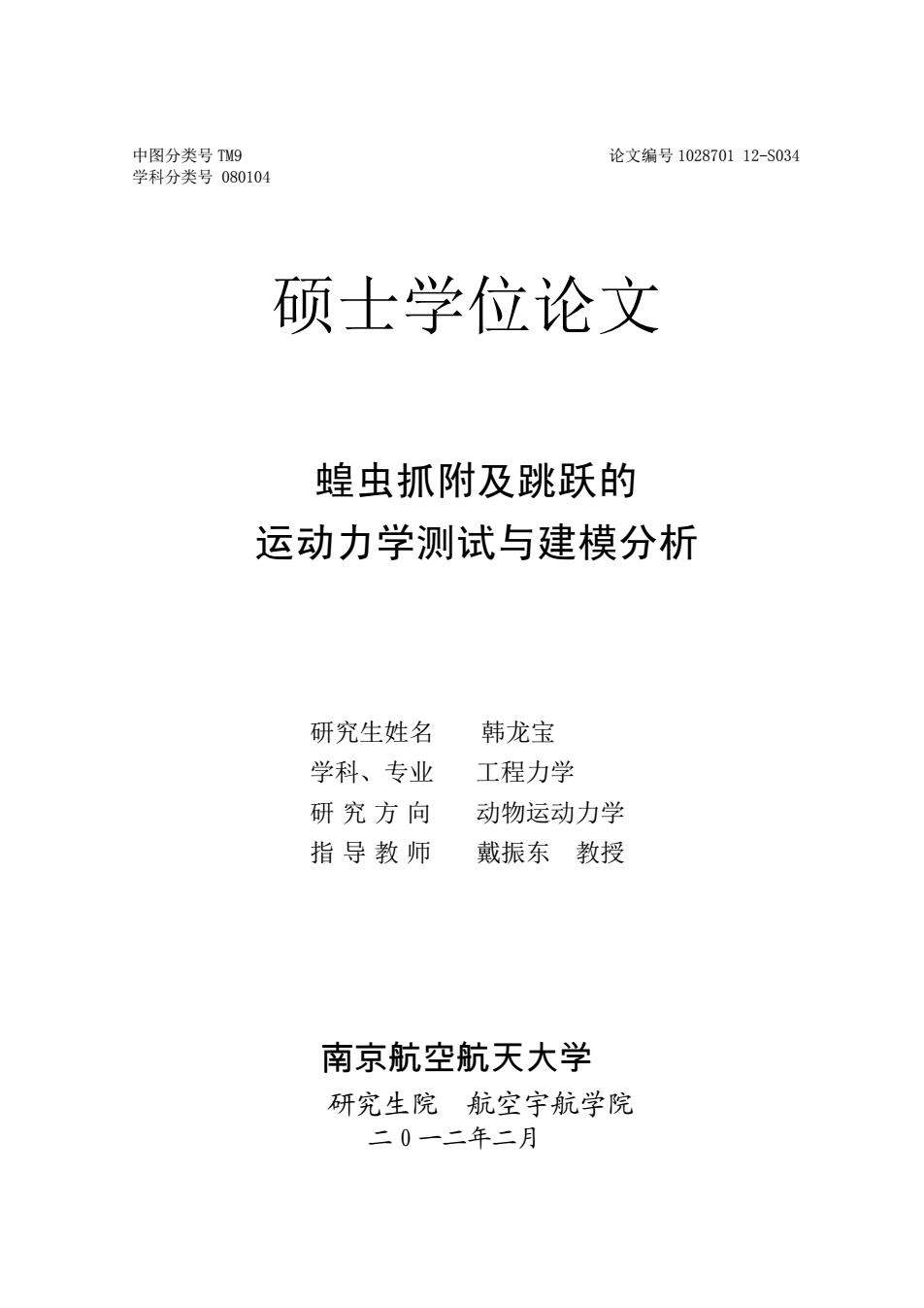
中图分类号TM9 论文编号102870112-S034 学科分类号080104 硕士学位论文 蝗虫抓附及跳跃的 运动力学测试与建模分析 研究生姓名 韩龙宝 学科、专业 工程力学 研究方向 动物运动力学 指导教师 戴振东教授 南京航空航天大学 研究生院航空宇航学院 二0一二年二月
中图分类号 TM9 论文编号 1028701 12-S034 学科分类号 080104 硕士学位论文 蝗虫抓附及跳跃的 运动力学测试与建模分析 研究生姓名 韩龙宝 学科、专业 工程力学 研 究 方 向 动物运动力学 指 导 教 师 戴振东 教授 南京航空航天大学 研究生院 航空宇航学院 二 0 一二年二月


Nanjing University of Aeronautics and Astronautics The Graduate School College of Aerospace Engineering Analysis of locust's grasping and jumping kinematical reaction force experiment A Thesis in Engineering Mechanics by Han Longbao Advised by Prof.Zhendong Dai Submitted in Partial Fulfillment of the Requirements for the Degree of Master of Engineering February,2012
Nanjing University of Aeronautics and Astronautics The Graduate School College of Aerospace Engineering Analysis of locust’s grasping and jumping kinematical reaction force experiment A Thesis in Engineering Mechanics by Han Longbao Advised by Prof. Zhendong Dai Submitted in Partial Fulfillment of the Requirements for the Degree of Master of Engineering February, 2012

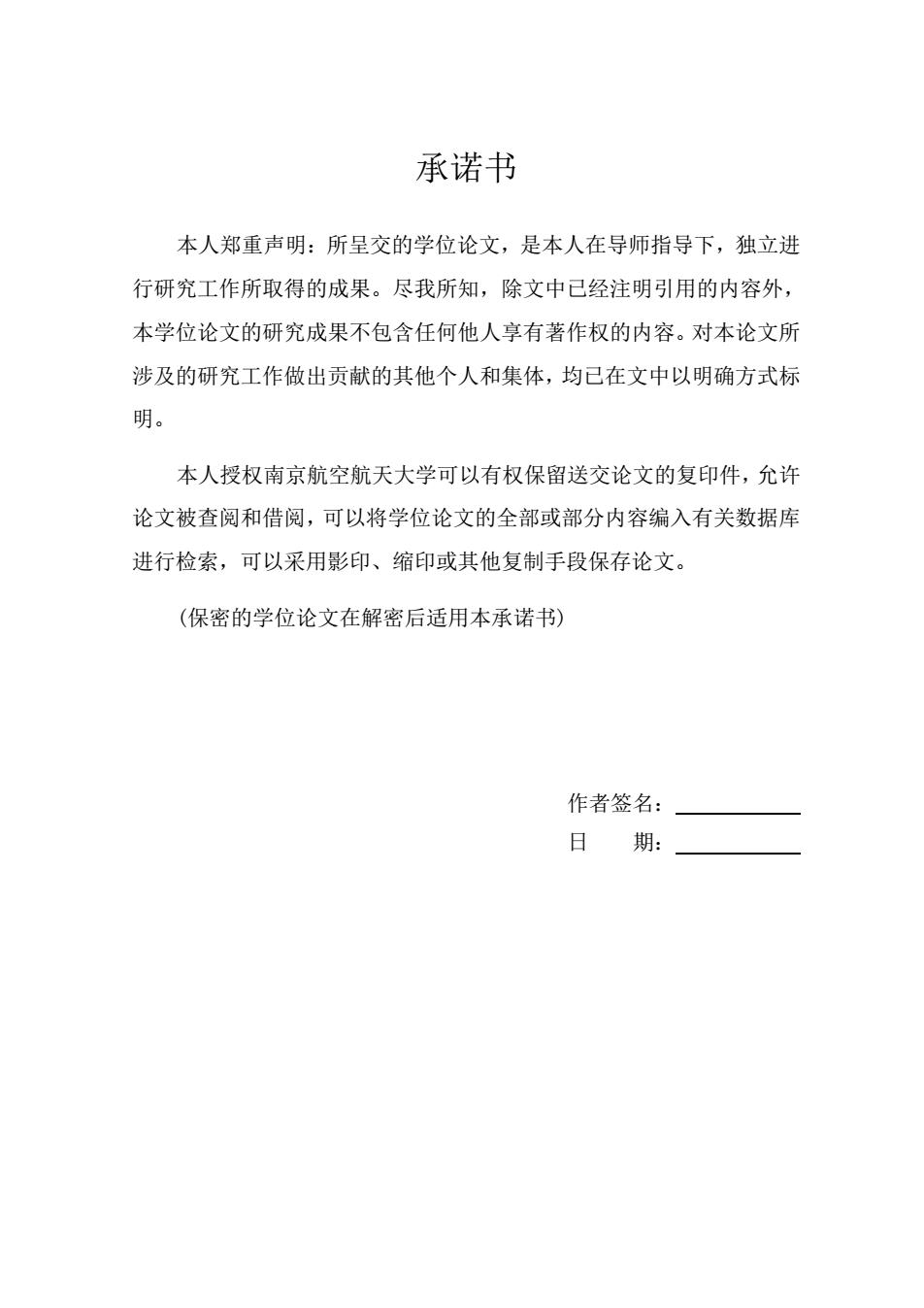
承诺书 本人郑重声明:所呈交的学位论文,是本人在导师指导下,独立进 行研究工作所取得的成果。尽我所知,除文中已经注明引用的内容外, 本学位论文的研究成果不包含任何他人享有著作权的内容。对本论文所 涉及的研究工作做出贡献的其他个人和集体,均已在文中以明确方式标 明。 本人授权南京航空航天大学可以有权保留送交论文的复印件,允许 论文被查阅和借阅,可以将学位论文的全部或部分内容编入有关数据库 进行检索,可以采用影印、缩印或其他复制手段保存论文。 (保密的学位论文在解密后适用本承诺书) 作者签名: 日 期:
承诺书 本人郑重声明:所呈交的学位论文,是本人在导师指导下,独立进 行研究工作所取得的成果。尽我所知,除文中已经注明引用的内容外, 本学位论文的研究成果不包含任何他人享有著作权的内容。对本论文所 涉及的研究工作做出贡献的其他个人和集体,均已在文中以明确方式标 明。 本人授权南京航空航天大学可以有权保留送交论文的复印件,允许 论文被查阅和借阅,可以将学位论文的全部或部分内容编入有关数据库 进行检索,可以采用影印、缩印或其他复制手段保存论文。 (保密的学位论文在解密后适用本承诺书) 作者签名: 日 期:

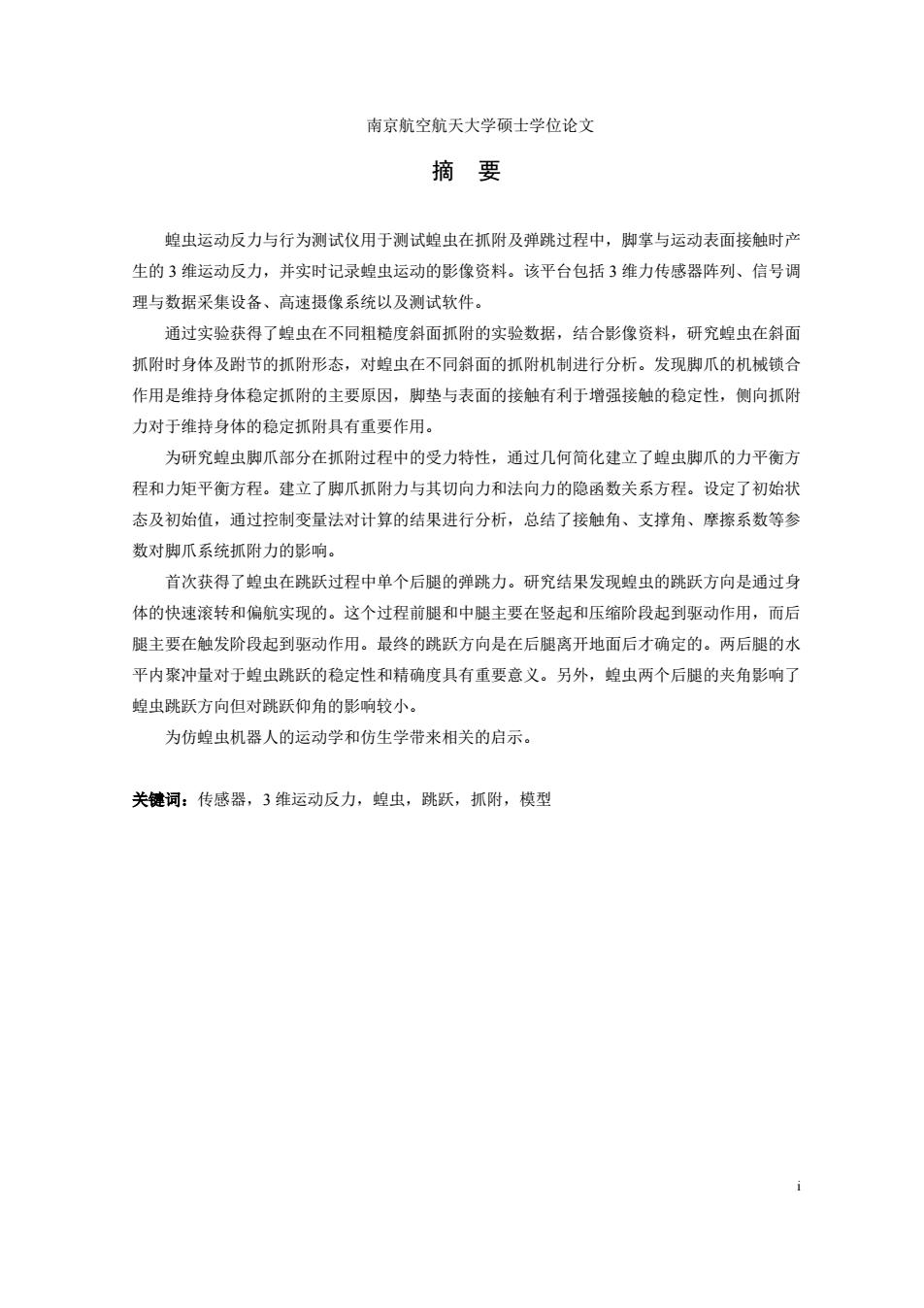
南京航空航天大学硕士学位论文 摘要 蝗虫运动反力与行为测试仪用于测试蝗虫在抓附及弹跳过程中,脚掌与运动表面接触时产 生的3维运动反力,并实时记录蝗虫运动的影像资料。该平台包括3维力传感器阵列、信号调 理与数据采集设备、高速摄像系统以及测试软件。 通过实验获得了蝗虫在不同粗糙度斜面抓附的实验数据,结合影像资料,研究蝗虫在斜面 抓附时身体及跗节的抓附形态,对蝗虫在不同斜面的抓附机制进行分析。发现脚爪的机械锁合 作用是维持身体稳定抓附的主要原因,脚垫与表面的接触有利于增强接触的稳定性,侧向抓附 力对于维持身体的稳定抓附具有重要作用。 为研究蝗虫脚爪部分在抓附过程中的受力特性,通过几何简化建立了蝗虫脚爪的力平衡方 程和力矩平衡方程。建立了脚爪抓附力与其切向力和法向力的隐函数关系方程。设定了初始状 态及初始值,通过控制变量法对计算的结果进行分析,总结了接触角、支撑角、摩擦系数等参 数对脚爪系统抓附力的影响。 首次获得了蝗虫在跳跃过程中单个后腿的弹跳力。研究结果发现蝗虫的跳跃方向是通过身 体的快速滚转和偏航实现的。这个过程前腿和中腿主要在竖起和压缩阶段起到驱动作用,而后 腿主要在触发阶段起到驱动作用。最终的跳跃方向是在后腿离开地面后才确定的。两后腿的水 平内聚冲量对于蝗虫跳跃的稳定性和精确度具有重要意义。另外,蝗虫两个后腿的夹角影响了 蝗虫跳跃方向但对跳跃仰角的影响较小。 为仿蝗虫机器人的运动学和仿生学带来相关的启示。 关键词:传感器,3维运动反力,蝗虫,跳跃,抓附,模型 i
南京航空航天大学硕士学位论文 i 摘 要 蝗虫运动反力与行为测试仪用于测试蝗虫在抓附及弹跳过程中,脚掌与运动表面接触时产 生的 3 维运动反力,并实时记录蝗虫运动的影像资料。该平台包括 3 维力传感器阵列、信号调 理与数据采集设备、高速摄像系统以及测试软件。 通过实验获得了蝗虫在不同粗糙度斜面抓附的实验数据,结合影像资料,研究蝗虫在斜面 抓附时身体及跗节的抓附形态,对蝗虫在不同斜面的抓附机制进行分析。发现脚爪的机械锁合 作用是维持身体稳定抓附的主要原因,脚垫与表面的接触有利于增强接触的稳定性,侧向抓附 力对于维持身体的稳定抓附具有重要作用。 为研究蝗虫脚爪部分在抓附过程中的受力特性,通过几何简化建立了蝗虫脚爪的力平衡方 程和力矩平衡方程。建立了脚爪抓附力与其切向力和法向力的隐函数关系方程。设定了初始状 态及初始值,通过控制变量法对计算的结果进行分析,总结了接触角、支撑角、摩擦系数等参 数对脚爪系统抓附力的影响。 首次获得了蝗虫在跳跃过程中单个后腿的弹跳力。研究结果发现蝗虫的跳跃方向是通过身 体的快速滚转和偏航实现的。这个过程前腿和中腿主要在竖起和压缩阶段起到驱动作用,而后 腿主要在触发阶段起到驱动作用。最终的跳跃方向是在后腿离开地面后才确定的。两后腿的水 平内聚冲量对于蝗虫跳跃的稳定性和精确度具有重要意义。另外,蝗虫两个后腿的夹角影响了 蝗虫跳跃方向但对跳跃仰角的影响较小。 为仿蝗虫机器人的运动学和仿生学带来相关的启示。 关键词:传感器,3 维运动反力,蝗虫,跳跃,抓附,模型
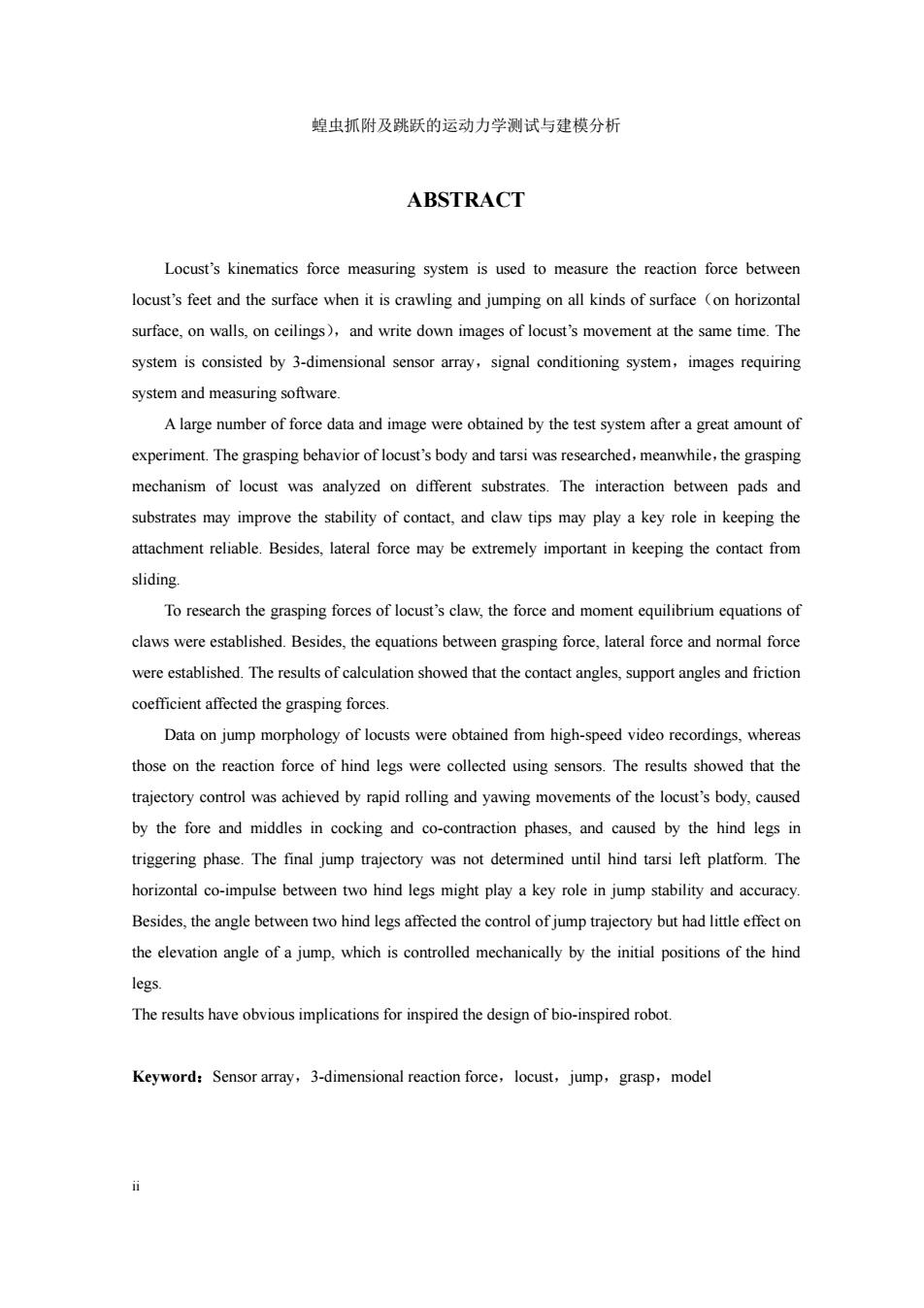
蝗虫抓附及跳跃的运动力学测试与建模分析 ABSTRACT Locust's kinematics force measuring system is used to measure the reaction force between locust's feet and the surface when it is crawling and jumping on all kinds of surface (on horizontal surface,on walls,on ceilings),and write down images of locust's movement at the same time.The system is consisted by 3-dimensional sensor array,signal conditioning system,images requiring system and measuring software. A large number of force data and image were obtained by the test system after a great amount of experiment.The grasping behavior of locust's body and tarsi was researched,meanwhile,the grasping mechanism of locust was analyzed on different substrates.The interaction between pads and substrates may improve the stability of contact,and claw tips may play a key role in keeping the attachment reliable.Besides,lateral force may be extremely important in keeping the contact from sliding. To research the grasping forces of locust's claw,the force and moment equilibrium equations of claws were established.Besides,the equations between grasping force,lateral force and normal force were established.The results of calculation showed that the contact angles,support angles and friction coefficient affected the grasping forces. Data on jump morphology of locusts were obtained from high-speed video recordings,whereas those on the reaction force of hind legs were collected using sensors.The results showed that the trajectory control was achieved by rapid rolling and yawing movements of the locust's body,caused by the fore and middles in cocking and co-contraction phases,and caused by the hind legs in triggering phase.The final jump trajectory was not determined until hind tarsi left platform.The horizontal co-impulse between two hind legs might play a key role in jump stability and accuracy Besides,the angle between two hind legs affected the control of jump trajectory but had little effect on the elevation angle of a jump,which is controlled mechanically by the initial positions of the hind legs. The results have obvious implications for inspired the design of bio-inspired robot. Keyword:Sensor array,3-dimensional reaction force,locust,jump,grasp,model
蝗虫抓附及跳跃的运动力学测试与建模分析 ii ABSTRACT Locust‟s kinematics force measuring system is used to measure the reaction force between locust‟s feet and the surface when it is crawling and jumping on all kinds of surface(on horizontal surface, on walls, on ceilings),and write down images of locust‟s movement at the same time. The system is consisted by 3-dimensional sensor array,signal conditioning system,images requiring system and measuring software. A large number of force data and image were obtained by the test system after a great amount of experiment. The grasping behavior of locust‟s body and tarsi was researched,meanwhile,the grasping mechanism of locust was analyzed on different substrates. The interaction between pads and substrates may improve the stability of contact, and claw tips may play a key role in keeping the attachment reliable. Besides, lateral force may be extremely important in keeping the contact from sliding. To research the grasping forces of locust‟s claw, the force and moment equilibrium equations of claws were established. Besides, the equations between grasping force, lateral force and normal force were established. The results of calculation showed that the contact angles, support angles and friction coefficient affected the grasping forces. Data on jump morphology of locusts were obtained from high-speed video recordings, whereas those on the reaction force of hind legs were collected using sensors. The results showed that the trajectory control was achieved by rapid rolling and yawing movements of the locust‟s body, caused by the fore and middles in cocking and co-contraction phases, and caused by the hind legs in triggering phase. The final jump trajectory was not determined until hind tarsi left platform. The horizontal co-impulse between two hind legs might play a key role in jump stability and accuracy. Besides, the angle between two hind legs affected the control of jump trajectory but had little effect on the elevation angle of a jump, which is controlled mechanically by the initial positions of the hind legs. The results have obvious implications for inspired the design of bio-inspired robot. Keyword:Sensor array,3-dimensional reaction force,locust,jump,grasp,model

南京航空航天大学硕士学位论文 目 录 第一章绪论… .1 1.1引言. .1 1.2本文的研究内容.… 1 1.2.1研究目的与意义 1 1.2.2国内外研究状况 2 1.3本文的主要工作.… 3 第二章蝗虫运动力学测试方法 5 2.1实验材料… 5 2.1.1蝗虫的腿结构 .5 2.1.2蝗虫的跗节.… .6 2.13实验蝗虫的准备 7 2.2实验设备… 7 2.2.1蝗虫斜面抓附力与行为测试系统 .7 2.2.2蝗虫弹跳力与行为测试系统… 8 2.23蝗虫跗节与砂纸表面形貌测试设备 .9 2.3实验过程及数据处理. 10 2.31蝗虫斜面抓附实验流程 10 2.3.2蝗虫跳跃实验流程.… .1l 2.3.3数据处理… 12 2.4小结.… 13 第三章粗糙斜面上蝗虫抓附机制研究. .14 3.1蝗虫在不同粗糙表面抓附力和脱附角… .14 3.2蝗虫脚爪尖端与砂纸表面颗粒微观形貌 16 3.3蝗虫在不同斜面上的抓附形态 18 3.3.1身体抓附形态 18 3.3.2跗节抓附形态 19 3.4蝗虫斜面抓附模型 20 3.41蝗虫斜面抓附模型 20 3.4.2脚爪尖端和砂纸颗粒接触的模型. 21 3.5小结… 24 第四章蝗虫脚爪的力学建模与稳定性分析 25 4.1脚爪系统力学分析 25 4.1.1运动中抓附力作用过程 25 4.1.2蝗虫脚爪系统力学平衡方程. 25 4.2抓附力的分解.… 26 4.2.1不饱和摩擦角 26 4.22抓附力与切向力、法向力关系方程 26
南京航空航天大学硕士学位论文 iii 目 录 第一章 绪论 ..........................................................................................................................................1 1.1 引言 .........................................................................................................................................1 1.2 本文的研究内容......................................................................................................................1 1.2.1 研究目的与意义...........................................................................................................1 1.2.2 国内外研究状况...........................................................................................................2 1.3 本文的主要工作......................................................................................................................3 第二章 蝗虫运动力学测试方法...........................................................................................................5 2.1 实验材料 .................................................................................................................................5 2.1.1 蝗虫的腿结构...............................................................................................................5 2.1.2 蝗虫的跗节...................................................................................................................6 2.1.3 实验蝗虫的准备...........................................................................................................7 2.2 实验设备 .................................................................................................................................7 2.2.1 蝗虫斜面抓附力与行为测试系统...............................................................................7 2.2.2 蝗虫弹跳力与行为测试系统.......................................................................................8 2.2.3 蝗虫跗节与砂纸表面形貌测试设备...........................................................................9 2.3 实验过程及数据处理............................................................................................................10 2.3.1 蝗虫斜面抓附实验流程.............................................................................................10 2.3.2 蝗虫跳跃实验流程.....................................................................................................11 2.3.3 数据处理.....................................................................................................................12 2.4 小结 .......................................................................................................................................13 第三章 粗糙斜面上蝗虫抓附机制研究.............................................................................................14 3.1 蝗虫在不同粗糙表面抓附力和脱附角................................................................................14 3.2 蝗虫脚爪尖端与砂纸表面颗粒微观形貌............................................................................16 3.3 蝗虫在不同斜面上的抓附形态............................................................................................18 3.3.1 身体抓附形态.............................................................................................................18 3.3.2 跗节抓附形态.............................................................................................................19 3.4 蝗虫斜面抓附模型................................................................................................................20 3.4.1 蝗虫斜面抓附模型.....................................................................................................20 3.4.2 脚爪尖端和砂纸颗粒接触的模型.............................................................................21 3.5 小结 .......................................................................................................................................24 第四章 蝗虫脚爪的力学建模与稳定性分析.....................................................................................25 4.1 脚爪系统力学分析................................................................................................................25 4.1.1 运动中抓附力作用过程.............................................................................................25 4.1.2 蝗虫脚爪系统力学平衡方程.....................................................................................25 4.2 抓附力的分解........................................................................................................................26 4.2.1 不饱和摩擦角.............................................................................................................26 4.2.2 抓附力与切向力、法向力关系方程.........................................................................26
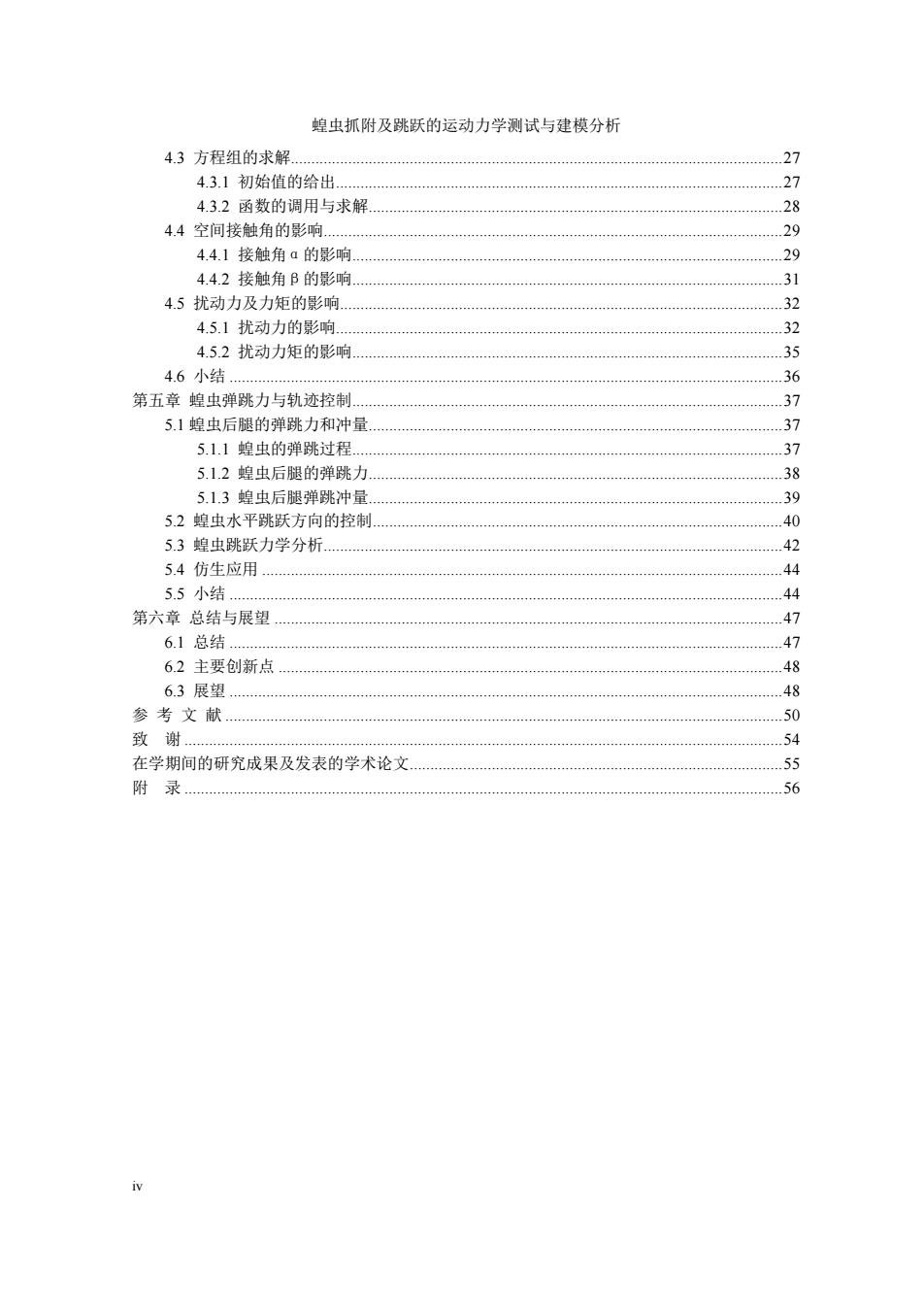
蝗虫抓附及跳跃的运动力学测试与建模分析 4.3方程组的求解 27 4.3.1初始值的给出 27 4.32函数的调用与求解 28 4.4空间接触角的影响. 29 4.4.1接触角a的影响 29 4.4.2接触角B的影响 31 4.5扰动力及力矩的影响 32 4.5.1扰动力的影响… 32 4.5.2扰动力矩的影响… 35 4.6小结… 36 第五章蝗虫弹跳力与轨迹控制 37 5.1蝗虫后腿的弹跳力和冲量. 37 5.1.1蝗虫的弹跳过程 37 5.1.2蝗虫后腿的弹跳力 38 5.1.3蝗虫后腿弹跳冲量 39 5.2蝗虫水平跳跃方向的控制 40 5.3蝗虫跳跃力学分析 5.4仿生应用… .44 5.5小结 44 第六章总结与展望 47 6.1总结 6.2主要创新点 48 6.3展望 48 参考文献 50 致谢… 54 在学期间的研究成果及发表的学术论文 55 附录 56 iv
蝗虫抓附及跳跃的运动力学测试与建模分析 iv 4.3 方程组的求解........................................................................................................................27 4.3.1 初始值的给出.............................................................................................................27 4.3.2 函数的调用与求解.....................................................................................................28 4.4 空间接触角的影响................................................................................................................29 4.4.1 接触角α的影响.........................................................................................................29 4.4.2 接触角β的影响.........................................................................................................31 4.5 扰动力及力矩的影响............................................................................................................32 4.5.1 扰动力的影响.............................................................................................................32 4.5.2 扰动力矩的影响.........................................................................................................35 4.6 小结 .......................................................................................................................................36 第五章 蝗虫弹跳力与轨迹控制.........................................................................................................37 5.1 蝗虫后腿的弹跳力和冲量.....................................................................................................37 5.1.1 蝗虫的弹跳过程.........................................................................................................37 5.1.2 蝗虫后腿的弹跳力.....................................................................................................38 5.1.3 蝗虫后腿弹跳冲量.....................................................................................................39 5.2 蝗虫水平跳跃方向的控制....................................................................................................40 5.3 蝗虫跳跃力学分析................................................................................................................42 5.4 仿生应用 ...............................................................................................................................44 5.5 小结 .......................................................................................................................................44 第六章 总结与展望 ............................................................................................................................47 6.1 总结 .......................................................................................................................................47 6.2 主要创新点 ...........................................................................................................................48 6.3 展望 .......................................................................................................................................48 参 考 文 献 ........................................................................................................................................50 致 谢 ..................................................................................................................................................54 在学期间的研究成果及发表的学术论文...........................................................................................55 附 录 ..................................................................................................................................................56